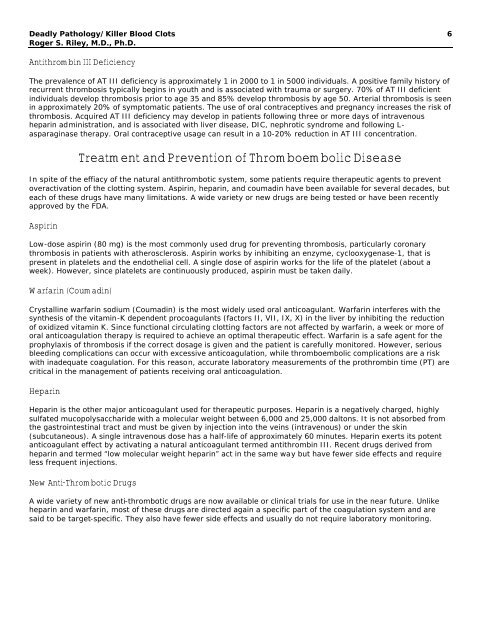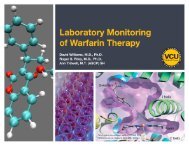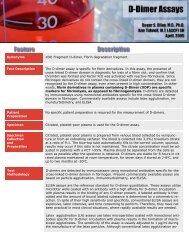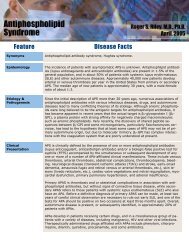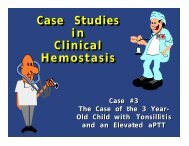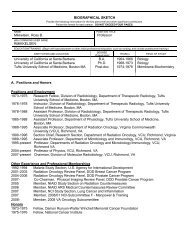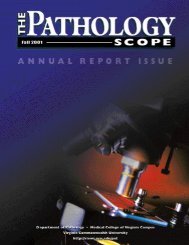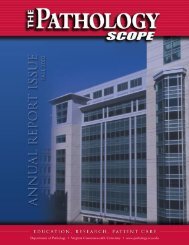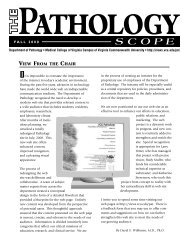What You Should Know About Abnormal Blood Clotting - Pathology
What You Should Know About Abnormal Blood Clotting - Pathology
What You Should Know About Abnormal Blood Clotting - Pathology
Create successful ePaper yourself
Turn your PDF publications into a flip-book with our unique Google optimized e-Paper software.
Deadly <strong>Pathology</strong>/Killer <strong>Blood</strong> Clots<br />
Roger S. Riley, M.D., Ph.D.<br />
6<br />
Antithrombin III Deficiency<br />
The prevalence of AT III deficiency is approximately 1 in 2000 to 1 in 5000 individuals. A positive family history of<br />
recurrent thrombosis typically begins in youth and is associated with trauma or surgery. 70% of AT III deficient<br />
individuals develop thrombosis prior to age 35 and 85% develop thrombosis by age 50. Arterial thrombosis is seen<br />
in approximately 20% of symptomatic patients. The use of oral contraceptives and pregnancy increases the risk of<br />
thrombosis. Acquired AT III deficiency may develop in patients following three or more days of intravenous<br />
heparin administration, and is associated with liver disease, DIC, nephrotic syndrome and following L-<br />
asparaginase therapy. Oral contraceptive usage can result in a 10-20% reduction in AT III concentration.<br />
Treatment and Prevention of Thromboembolic Disease<br />
In spite of the effiacy of the natural antithrombotic system, some patients require therapeutic agents to prevent<br />
overactivation of the clotting system. Aspirin, heparin, and coumadin have been available for several decades, but<br />
each of these drugs have many limitations. A wide variety or new drugs are being tested or have been recently<br />
approved by the FDA.<br />
Aspirin<br />
Low-dose aspirin (80 mg) is the most commonly used drug for preventing thrombosis, particularly coronary<br />
thrombosis in patients with atherosclerosis. Aspirin works by inhibiting an enzyme, cyclooxygenase-1, that is<br />
present in platelets and the endothelial cell. A single dose of aspirin works for the life of the platelet (about a<br />
week). However, since platelets are continuously produced, aspirin must be taken daily.<br />
Warfarin (Coumadin)<br />
Crystalline warfarin sodium (Coumadin) is the most widely used oral anticoagulant. Warfarin interferes with the<br />
synthesis of the vitamin-K dependent procoagulants (factors II, VII, IX, X) in the liver by inhibiting the reduction<br />
of oxidized vitamin K. Since functional circulating clotting factors are not affected by warfarin, a week or more of<br />
oral anticoagulation therapy is required to achieve an optimal therapeutic effect. Warfarin is a safe agent for the<br />
prophylaxis of thrombosis if the correct dosage is given and the patient is carefully monitored. However, serious<br />
bleeding complications can occur with excessive anticoagulation, while thromboembolic complications are a risk<br />
with inadequate coagulation. For this reason, accurate laboratory measurements of the prothrombin time (PT) are<br />
critical in the management of patients receiving oral anticoagulation.<br />
Heparin<br />
Heparin is the other major anticoagulant used for therapeutic purposes. Heparin is a negatively charged, highly<br />
sulfated mucopolysaccharide with a molecular weight between 6,000 and 25,000 daltons. It is not absorbed from<br />
the gastrointestinal tract and must be given by injection into the veins (intravenous) or under the skin<br />
(subcutaneous). A single intravenous dose has a half-life of approximately 60 minutes. Heparin exerts its potent<br />
anticoagulant effect by activating a natural anticoagulant termed antithrombin III. Recent drugs derived from<br />
heparin and termed “low molecular weight heparin” act in the same way but have fewer side effects and require<br />
less frequent injections.<br />
New Anti-Thrombotic Drugs<br />
A wide variety of new anti-thrombotic drugs are now available or clinical trials for use in the near future. Unlike<br />
heparin and warfarin, most of these drugs are directed again a specific part of the coagulation system and are<br />
said to be target-specific. They also have fewer side effects and usually do not require laboratory monitoring.


